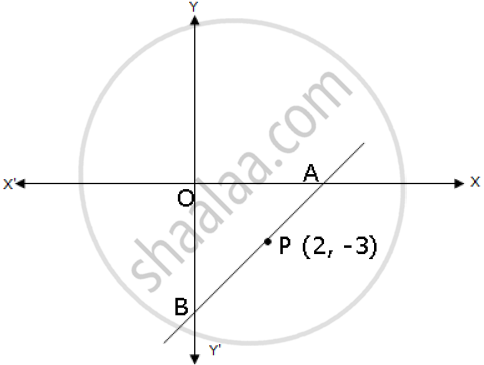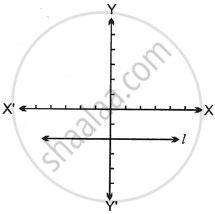Advertisements
Advertisements
Question
Determine whether the following point is collinear.
A(–4, 4), \[K\left( - 2, \frac{5}{2} \right),\] N (4, –2)
Solution
A(–4, 4), \[K\left( - 2, \frac{5}{2} \right),\] N (4, –2)
Slope of AK = `(5/2 - 4)/((-2) - (- 4))`
= `((5 - 8)/2)/((-2) + 4)`
= `((-3)/2)/2`
= `((-3)/2)/(2/1) = (-3)/2 xx 1/2 = (-3)/(2 xx 2)`
= `(-3)/4`
\[\text { Slope of KN } = \frac{(- 2) - \frac{5}{2}}{4 - \left( - 2 \right)}\]
= `(((-4) - 5)/2)/(4 + 2)`
= `((-9)/2)/(6/1) = (- 9)/2 xx 1/6 = (-9)/(6 xx 2) = (- 9)/12`
= `(- 3)/4`
Slope of AK = Slope of KN
Thus, the given points are collinear.
APPEARS IN
RELATED QUESTIONS
A slope of a line is 3 and y-intercept is –4. Write the equation of a line
A and B are two points on the x-axis and y-axis respectively. P (2, −3) is the midpoint of AB. Find the:
(1) coordinates of A and B
(2) slope of line AB.
(3) an equation of line AB.

Find the slope of the line perpendicular to AB if : A = (0, −5) and B = (−2, 4)
Find the value(s) of k so that PQ will be parallel to RS. Given : P(3, −1), Q(7, 11), R(−1, −1) and S(1, k)
Find the value of k for which the lines kx – 5y + 4 = 0 and 5x – 2y + 5 = 0 are perpendicular to each other.
Angle made by the line with the positive direction of X-axis is given. Find the slope of the line.
45°
Find the slope of the lines passing through the given point.
T (0, –3) , S (0, 4)
Determine whether the following point is collinear.
P(2, –5), Q(1, –3), R(–2, 3)
Determine whether the following point is collinear.
R(1, –4), S(–2, 2), T(–3, 4)
Fill in the blank using correct alternative.
Distance of point (–3, 4) from the origin is ______.
Show that the line joining the points A(4, 8) and B(5, 5) is parallel to the line joining the points C(2, 4) and D(1, 7).
Find the slope of a line passing through the given pair of points (0,5) and (5,0)
Verify whether the following points are collinear or not:
A(1, –3), B(2, –5), C(–4, 7).
Find the slope of the line passing through the points M(4,0) and N(-2,-3).
Show that the line joining (2, – 3) and (- 5, 1) is:
(i) Parallel to line joining (7, -1) and (0, 3).
(ii) Perpendicular to the line joining (4, 5) and (0, -2).
In the figure, line l is parallel to X-axis. Which of the following statement is true?

